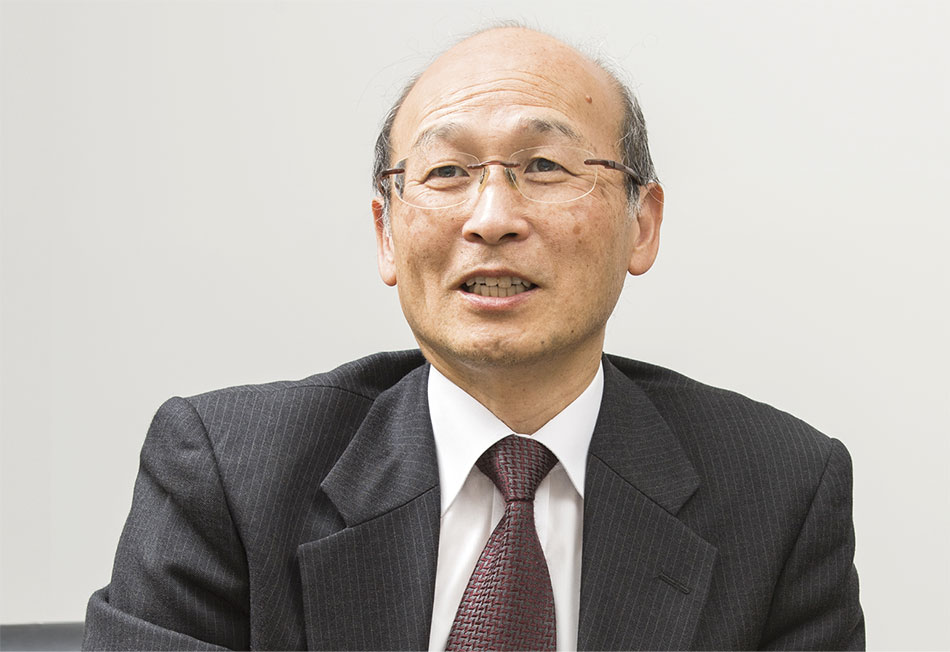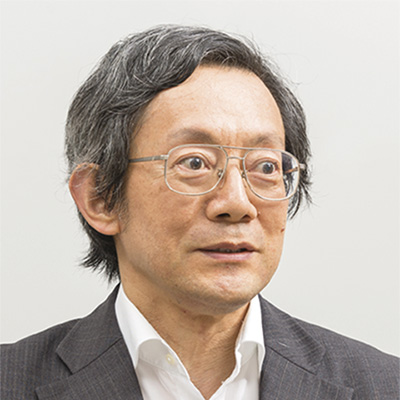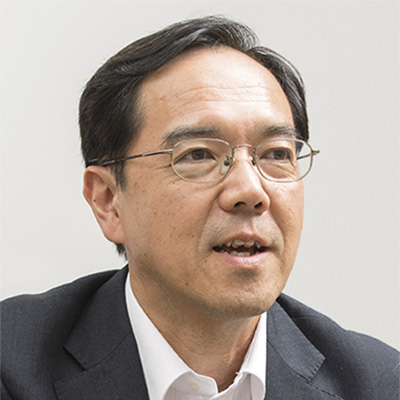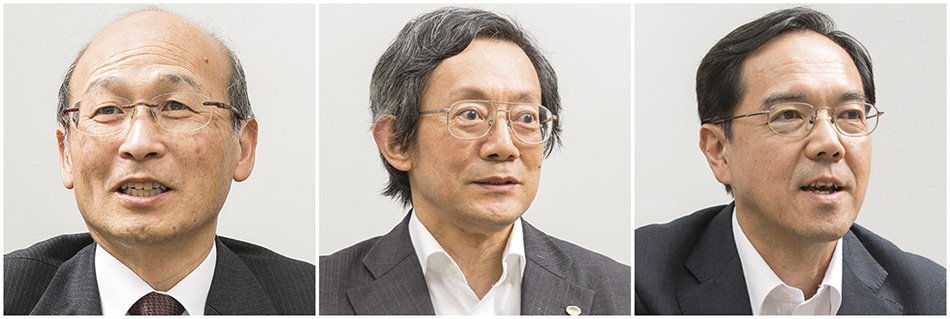Technology has Changed Lifestyles and Society
 Seiichi Shin
Seiichi Shin
Professor, Graduate School of Informatics and Engineering, The University of Electro-Communications
Seiichi Shin received an M.S. degree from the University of Tokyo Department of Mechanical Engineering in 1980. From 1992 an Associate Professor in the Faculty of Engineering at the University of Tokyo and from 2006 a Professor at the University of Electro-Communications. Doctor of Engineering. Fellow and former Chairman of the Society of Instrument and Control Engineers. Councilor at the Manufacturing Science and Technology Center, and Director at the Control System Security Center.
Tachi:This issue of Hitachi Review is titled “Technology for Living and Life,” and among the infrastructure system technologies for supporting lifestyles, we’re focusing on the water environment as well as on disaster prevention and security.
In recent years, the rapidly increasing demand for resources and energy resulting from economic development, the increasing severity of climate change, and growing economic disparities have become common issues throughout the world, and the impact on people’s lives and foundational infrastructure systems is spreading. Considering that background, I would like to ask you how infrastructure should change in the future.
Shin:The rich and convenient lifestyle we enjoy today is supported by various technologies provided by our predecessors. But from another perspective, technology has allowed us to exceed our capacity and evolutionary limits as human beings, and so it can be viewed as changing our lifestyles and society. From the industrialized society that arose from mechanical technologies like the motors that were Hitachi, Ltd.’s founding product to the information society that has arisen from information technology (IT), the pace at which we are advancing is accelerating. In the Society 5.0(a)image of future society, advances such as artificial intelligence (AI) will further accelerate the pace of development, to the point where the growth curve of humanity and society is predicted to reach a “singularity”(b). The relationship between technology and humanity is thus at a turning point. When considering technologies for lifestyle infrastructure, we must consider such change alongside the relationship between humanity and technology.
- (a) Society 5.0
- A series of initiatives toward realizing a “super-smart society” in which cyberspace and physical spaces are tightly integrated, as advocated by the Japanese government in its 5th Science and Technology Basic Plan. The name indicates scientific and technological innovation that leads to innovation for the creation of a new society, a successor in the progress from hunting to agricultural, industrial, and information societies.
- (b) Singularity
- The advancement of AI to such an extent that it exceeds human intelligence, the use of which marks the arrival at a singularity (a point that is discontinuous from previous progress) in the evolution of human intelligence.
Using Technology to Make Everyone Happy
 Takahiro Tachi
Takahiro Tachi
Chief Engineer, Water Solutions Division, Water Business Unit, Hitachi, Ltd.
Tachi:Will requirements for lifestyle infrastructure change as technology accelerates the pace of evolution?
Shin:There may not be large differences in basic human needs, but raising minimum standards of living in the future will require addressing the evolution of technology from a global perspective, not only in developed countries. To address the common global issues you mentioned before, the United Nations has proposed Sustainable Development Goals (SDGs), which aim at things like eradicating poverty and hunger and ensuring access to water and sanitation. Raising minimum standards of living will have effects such as reducing factors leading to terrorism and military conflicts, and is therefore highly significant from the perspective of security. One indispensable element for achieving this is improvement of lifestyle infrastructure through economic and technical support from the international community.
Tachi:Hitachi has also been engaged in business with the SDGs in mind, and we believe that there are many contributions that we can make through technology.
Shin:The idea of using technology to make everyone happier is also consistent with Hitachi’s founding spirit. What’s important is to provide truly necessary technologies that meet with the realities of each country or region, aiming for a way that lets both Hitachi and its customers develop sustainably. In particular, emerging and developing countries have a strong need for contributions to infrastructure development based on the experience of developed countries, so I think that it is important to take inventory of all the technologies accumulated by Hitachi over the past century—from motors to its recent Internet of Things (IoT) platform Lumada—and organize them so that they can be used when necessary.
Tachi:Recently in the field of infrastructure, technologies that were once developed for domestic use and subsequently forgotten have started attracting interest overseas. What’s important is not that these are the latest, cutting-edge technologies, but that consideration is being given to what’s necessary for resolving issues.
Using Cyber to Go beyond Physical Bounds
 Takeshi Miyao
Takeshi Miyao
General Manager, Security Business Division, Services & Platforms Business Unit, Hitachi, Ltd.
Miyao:Of course, digital transformation has also progressed in cutting-edge fields, and cyber domains are expanding. How do you think this will change lifestyle infrastructure?
Shin:The relationship between cyber and physical is an indispensable factor when considering directions of change in lifestyle infrastructure. Recently CPS(c) and IoT have become buzzwords, but mixing the virtual with the real is nothing new—the financial world has developed since long ago by incorporating the virtual concept of “credit.” However, if the virtual domain is overinflated and too far removed from reality, like in a bubble economy, it becomes dangerous. The key will be maintaining balance between the two, using cyber to advance beyond physical boundaries.
Tachi:Japan’s water supply and sewerage facilities are facing many issues, such as aging facilities, fewer experienced technicians, and smaller budgets. There are movements toward overcoming these issues using digital technologies like CPS and IoT, but what do you think, as a new committee member on the Waterworks CPS Committee of the Ministry of Economy, Trade and Industry and the Ministry of Health, Labour and Welfare?
Shin:The important thing is to discern what will change and what will not. In Japan, mutual effort between public and private entities has realized a stable, safe, and secure water supply. We need to consider how to protect these unchanging values using changing technologies in accordance with the era. For example, if waterworks stations are connected via cyberspace using the concept of symbiotic autonomous decentralization(d) proposed by Hitachi in addition to being physically linked via conduits, then it will be possible to advance system-wide optimization that enables efficiency and more flexible operations. That will make cooperation easier in the event of a disaster.
In asset management and the succession of operational technology (OT), we would ideally like to be able to integrate previously separate paper drafts, manuals, and other documents, and to simulate operations in a 3D facility map. It’s still necessary to experience actual work sites, but one advantage of digital technologies is that they allow virtual exploration of hard-to-see areas and simulation of unexpected occurrences that can’t be experienced in normal times. In the future, the lifestyle infrastructure lifecycle—from development, maintenance, and scaling down, to stable operation—will likely be experienced by other Asian countries as well. When those countries face similar challenges in the future, the technology and know-how accumulated going forward will surely be useful.
- (c) CPS
- An abbreviation for “cyber–physical system.” A system that realizes optimal control by collecting various physical space (real-world) states as data, appropriately analyzing the data in cyberspace using big data processing technologies, etc., and feeding the results back to the controlled object in physical space. This is a similar concept to the IoT, but CPS has a broader meaning, including embedded systems that fuse cyber and physical without passing through the Internet.
- (d) Symbiotic autonomous decentralization
- An extension to the system level of the autonomous decentralization concept that Hitachi has applied to systems for traffic and industrial control (constructing highly reliable and highly scalable systems through autonomous subsystem cooperation). In addition to optimizing on-site equipment and facilities, symbiotic autonomous decentralization also shares, analyzes, and utilizes information through to the management level for corporate-level, system-wide optimization, aiming to realize optimization and value creation throughout the value chain, including at other companies.
Explaining Technology so that Anyone can Understand It
Miyao:The advent of the CPS–IoT era has resulted in new challenges, such as cyber security for infrastructure. What are some of the issues we will face in protecting the safety and security of infrastructure?
Shin:In terms of safety and security in a digital society, “readability” is becoming in various ways an increasingly important issue for the future. It’s good that systems will get smarter through AI learning, but black-box situations where humans cannot see what changes have occurred as a result of learning are dangerous. If you leave everything up to the machine but you don’t understand what it’s doing, then you can’t respond to emergencies. Also, I hope that technicians and researchers start to emphasize technical communication. As technology is permeating our life more than ever, I think that in order to increase user security, there is a responsibility for documenting and explaining technology in a way that everyone can understand. Doing so will be important for establishing systems that can be maintained unchanged in the future, even when human resources who understand technology decrease in social infrastructure fields.
Tachi:OT for lifestyle infrastructure has two aspects—control and operation. Some core parts of control technologies are hard for non-engineers to understand, so it’s important to clearly describe expertise and know-how regarding their operations in manuals and the like.
Shin:For security, except for know-how and technologies that should remain confidential, it is necessary for people to be able to understand these things in order to respond to disasters and other emergencies. Japan experiences many natural disasters, so we have strengthened our ability to cope with disasters through a culture of mutual support. To further strengthen the business continuity and resilience of lifestyle infrastructure while taking advantage of these strengths, it is essential to prepare manuals beforehand to demonstrate how multiple organizations can coordinate their response to natural disasters. Additionally, we must conduct training using digital technologies such as simulations and implement PDCA (Plan–Do–Check–Act) cycles to improve our responsiveness and flexibility. I believe these are important pillars for both cyber and physical security measures.
Improving Human Abilities of Awareness
Miyao:Technological advances bring about new risks, but it is important to notice and correct problems through the PDCA cycle, don’t you think?
Shin:Yes, absolutely. Awareness is vital. An important point with respect to not leaving everything to machines, as I mentioned earlier, is the unique human ability for awareness. Improving awareness leads to resilience, or the ability to cope with unexpected change. Awareness ability requires a background of accumulated knowledge and experience, so the idea is to apply digital technologies to learning as soon as possible. While we are maintaining mature skills such as using acoustics to detect water leaks, we should also develop educational systems and detection systems that utilize digital technologies. The Confucian text Great Learning, one of the Four Books and Five Classics, has a stanza that says, “Things have their root and their branches. Affairs have their end and their beginning. To know what is first and what is last will lead near to what is taught in the Great Learning.” This describes the importance of correctly grasping first principles, which is indispensable for being a good engineer. Technological principles change with the times, but awareness of those principles is attained only after they are understood. From that, I hope that Hitachi will continue to protect the unchanging values of safety and security in lifestyle infrastructure by developing both cyber and physical technologies.
Miyao:Nowadays, there are fewer opportunities for learning principles through work, so that may be an issue. We will also contribute to realizing lifestyle infrastructure that can further enhance the resilience of society as a whole, while also working toward the succession of knowledge and technology within the company.
Thank you for speaking with us today.

